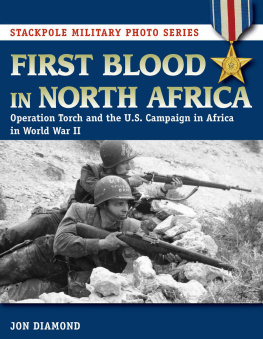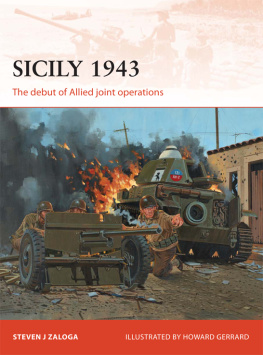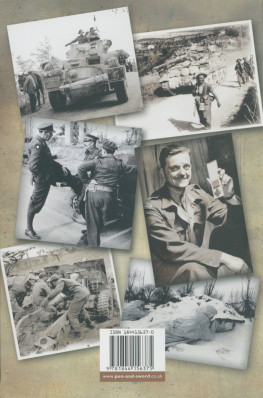
IMAGES OF WAR
THE INVASION OF SICILY 1943
RARE PHOTOGRAPHS FROM WARTIME ARCHIVES
Jon Diamond
First published in Great Britain in 2017 by
PEN & SWORD MILITARY
An imprint of
Pen & Sword Books Ltd
47 Church Street
Barnsley
South Yorkshire
S70 2AS
Copyright Jon Diamond, 2017
ISBN 978-1-47389-609-3
eISBN 978-1-47389-611-6
Mobi ISBN 978-1-47389-610-9
The right of Jon Diamond to be identified as author of this work has been asserted by him in accordance with the Copyright, Designs and Patents Act 1988.
A CIP catalogue record for this book is available from the British Library.
All rights reserved. No part of this book may be reproduced or transmitted in any form or by any means, electronic or mechanical including photocopying, recording or by any information storage and retrieval system, without permission from the Publisher in writing.
Pen & Sword Books Ltd incorporates the imprints of Pen & Sword Archaeology, Atlas, Aviation, Battleground, Discovery, Family History, History, Maritime, Military, Naval, Politics, Railways, Select, Social History, Transport, True Crime, and Claymore Press, Frontline Books, Leo Cooper, Praetorian Press, Remember When, Seaforth Publishing and Wharncliffe.
For a complete list of Pen & Sword titles please contact
PEN & SWORD BOOKS LIMITED
47 Church Street, Barnsley, South Yorkshire S70 2AS, England
E-mail:
Website: www.pen-and-sword.co.uk
Acknowledgements
T his archival photograph volume in the Images of War series is dedicated to the men and women who fought and perished during the thirty-eight-day campaign to wrest Sicily from Axis control in the summer of 1943. We ponder upon viewing the photographs to remind us of their heroic sacrifice to maintain freedom lest we forget. The author also wishes to acknowledge the many military history scholars including such names as Blumenson, DEste, Garland, Smyth, Porch, Whiting, Zaloga and Atkinson, to name but a few, who have catalogued the nuances of this campaign with their superlative prose. The author is indebted to the able assistance of the archivists at both the United States Army Military History Institute (USAMHI) at the United States Army War College in Carlisle, Pennsylvania and the Still Photo Section of the National Archives and Records Administration (NARA) in College Park, Maryland.
Chapter One
Strategic Prelude to the Invasion of Sicily
T he first official summit held between neutral Americas President Franklin D. Roosevelt and British Prime Minister Winston S. Churchill occurred during the Atlantic Conference in Placentia Bay, Canada on 89 August 1941. It would be another five months before the entry of the United States into the war, which followed Imperial Japans aerial attack on Pearl Harbor and invasion of the Philippine Archipelago. At that meeting in Newfoundland, Canada, nascent plans to better co-ordinate allocation of American war matriel and foodstuffs, through Lend-Lease, were reinforced. Both Britain and the Soviet Union, the latter invaded by Germany on 22 June 1941, were desperately attempting to contain the ceaseless expansion of Adolf Hitler and Benito Mussolinis Axis forces in North Africa and across Russia in order to protect the many strategic locales, such as the Suez Canal, the Caucasus and Middle Eastern oilfields, and Moscow. Also, at this Placentia Bay Conference in Canada, the Atlantic Charter was crafted that outlined the goals of the Allies for after defeating the Axis belligerents.
After the entry of the United States into the global conflict, the Combined Chiefs of Staff (CCS), a body comprising both American and British service chiefs and their principal aides, was formalised at the Arcadia Conference in Washington from 22 December to 14 January 1941. At this initial Washington Conference, the Allies decided that their major effort was to be directed towards Europe to ultimately bring about the defeat of Germany. Also, the Allied nations would not make any separate peace with the enemy. Even before Pearl Harbor, Roosevelt and Churchill considered the Nazi regime as a more dangerous threat to their countries and survival, and they had adopted a strategy to vanquish the Axis partners of Germany and Italy first. In Asia and the Pacific, primarily defensive or limited actions were to be conducted against the Japanese until European victory was secure. The ill-fated and short-lived American-British-Dutch-Australian (ABDA) command for the Far East, under British General Archibald Wavell, was also established at the Arcadia Conference. However, it was dissolved by mid-February 1942, following the ignoble defeats suffered by Allied forces at Singapore and throughout the Dutch East Indies at the hands of Imperial Japan.
The Japanese juggernaut of 19411942 over the Allies in the Far East and the Pacific established hegemony over a new Tokyo-controlled Greater East Asia Co-Prosperity Sphere. This enormous geographical area included a vast swathe of China along with total domination of Burma, Malaya and Singapore, the Dutch East Indies, the Philippine and Bismarck Archipelagos, and almost all of the Solomon Islands. Advanced Japanese bases along Papua New Guineas northern coast at Buna and Gona, as well as at Lae in North-east New Guineas Huon Peninsula, were established for Imperial Japanese Army (IJA) and Navy (IJN) offensive action against Port Moresby, which lay across the Arafura Sea from Australias Northern Territory. Australias northernmost principal port, Darwin, had been bombed by the Japanese from February 1942. A planned Japanese south-eastern thrust into the New Hebrides, Fiji and Tonga island groups, if accomplished, would have created havoc by severing American sea lanes to the Antipodes, thereby denying the Allies a strategically-important geographic springboard for future offensive operations.
The interval from October 1942 to January 1943 has been referred to as a turning of the tide in the epic struggle of the Second World War. During this three-month time-frame five major land campaigns were conducted leading to staggering losses for the Axis partners of Germany and Italy as well as for Imperial Japan, at the expense of a very attenuated Allied war production machine to meet the global confrontation requirements. These included the protracted battles by American and Australian formations for Papua, New Guinea; Guadalcanal, in the southern Solomon Islands of the South Pacific area; the defence of Stalingrad, resulting in the surrender of large numbers of Axis coalition troops, comprising mostly the Wehrmacht Sixth Army; the see-saw British and Dominion forces operations, first confronting the eastwardlyadvancing Italian Tenth Army; and then against General Erwin Rommels Deutsches Afrika Korps , combined with the remnants of Mussolinis North African expeditionary force, across the Western Desert encompassing Egypt and the Cyrenaican portion of Libya. These chaotic internecine engagements, employing both large mechanised forces as well as defensive lines, would initially culminate in the First and Second Battles of El Alamein in July and October 1942, respectively, and then the Anglo-American invasion of Vichy French-controlled Morocco and Algeria in north-west Africa on 8 November 1942, Operation Torch. A gruelling six-month campaign for control of Tunisia would ensue until May 1943.
At Guadalcanal in the Southern Solomon Islands, throughout a hellacious jungle and gruesome naval surface campaign from 7 August 1942 to 9 February 1943, the heroic defence by, initially, the 1st Marine Division (Reinforced) followed by regimental elements of the US Armys Americal Division enabled the Americans to maintain possession of Henderson Field as an unsinkable aircraft carrier. Coupled with the gallant sacrifices of Allied seamen and American pilots, IJN Combined Fleet Admiral Isoruku Yamamoto and IJA Lieutenant-General Harukichi Hyakutakes naval bombardment and island counter-attacks, respectively, failed to re-capture Guadalcanal, thereby deterring the potentially nightmarish maritime scenario of Japanese naval expansion into the South-eastern Pacific Ocean with potential severance of the sea lanes connecting the United States and Australia and New Zealand.
Next page










![Atkinson - An army at dawn: [the war in North Africa, 1942-1943]](/uploads/posts/book/178818/thumbs/atkinson-an-army-at-dawn-the-war-in-north.jpg)






